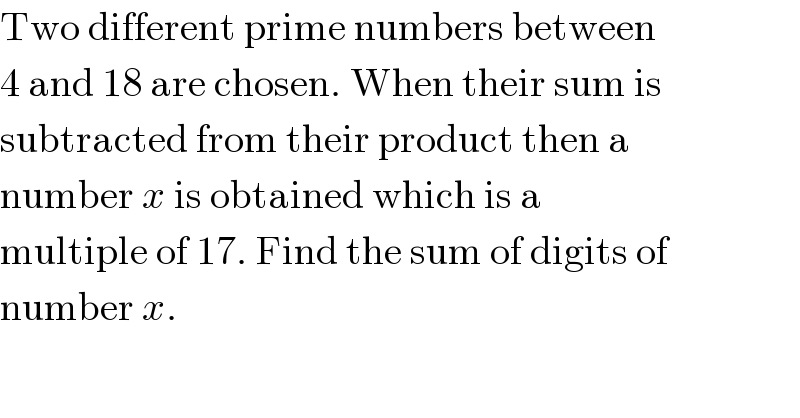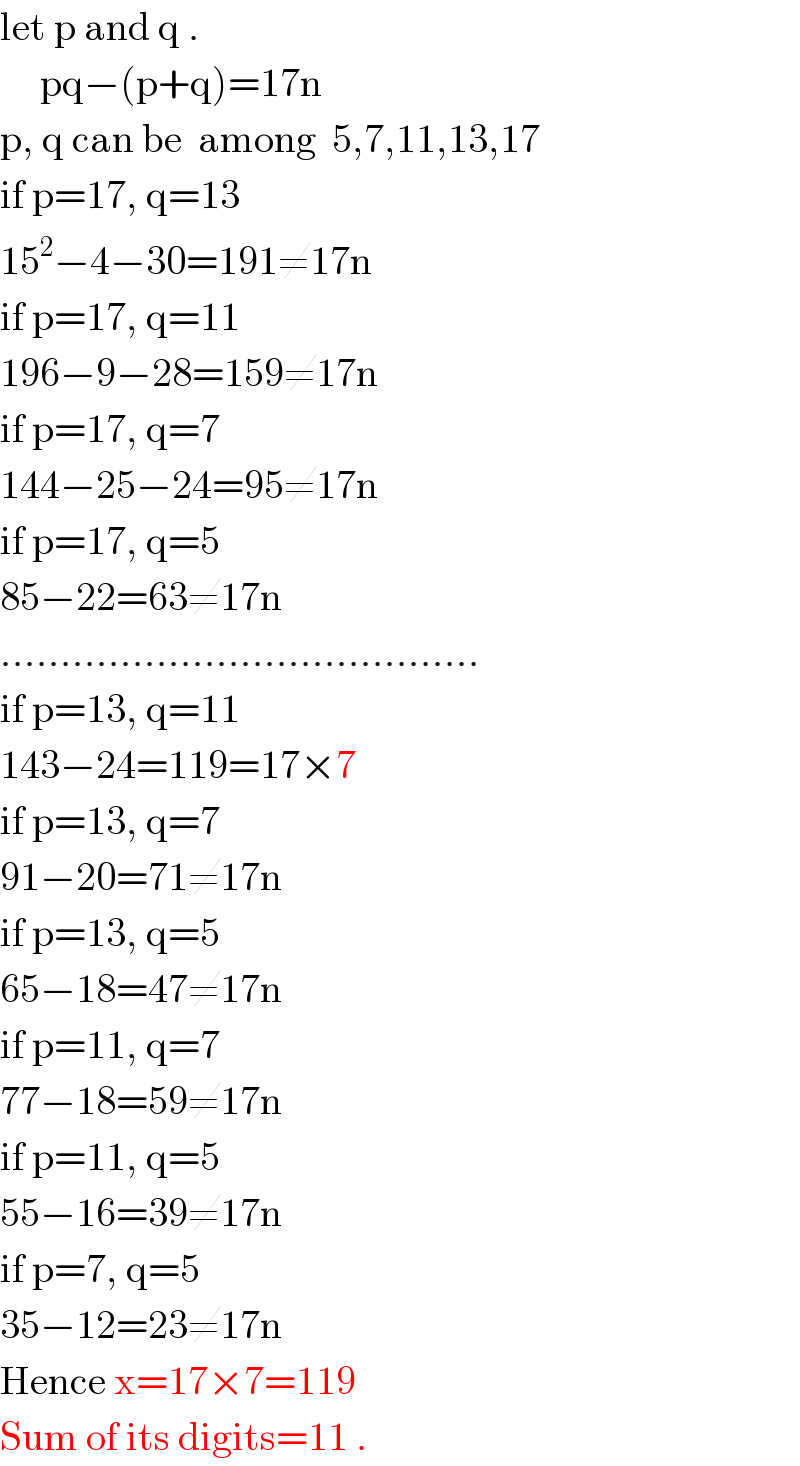Question Number 19631 by Tinkutara last updated on 13/Aug/17

$$\mathrm{Two}\:\mathrm{different}\:\mathrm{prime}\:\mathrm{numbers}\:\mathrm{between} \\ $$$$\mathrm{4}\:\mathrm{and}\:\mathrm{18}\:\mathrm{are}\:\mathrm{chosen}.\:\mathrm{When}\:\mathrm{their}\:\mathrm{sum}\:\mathrm{is} \\ $$$$\mathrm{subtracted}\:\mathrm{from}\:\mathrm{their}\:\mathrm{product}\:\mathrm{then}\:\mathrm{a} \\ $$$$\mathrm{number}\:{x}\:\mathrm{is}\:\mathrm{obtained}\:\mathrm{which}\:\mathrm{is}\:\mathrm{a} \\ $$$$\mathrm{multiple}\:\mathrm{of}\:\mathrm{17}.\:\mathrm{Find}\:\mathrm{the}\:\mathrm{sum}\:\mathrm{of}\:\mathrm{digits}\:\mathrm{of} \\ $$$$\mathrm{number}\:{x}. \\ $$
Answered by ajfour last updated on 13/Aug/17

$$\mathrm{let}\:\mathrm{p}\:\mathrm{and}\:\mathrm{q}\:. \\ $$$$\:\:\:\:\:\mathrm{pq}−\left(\mathrm{p}+\mathrm{q}\right)=\mathrm{17n} \\ $$$$\mathrm{p},\:\mathrm{q}\:\mathrm{can}\:\mathrm{be}\:\:\mathrm{among}\:\:\mathrm{5},\mathrm{7},\mathrm{11},\mathrm{13},\mathrm{17} \\ $$$$\mathrm{if}\:\mathrm{p}=\mathrm{17},\:\mathrm{q}=\mathrm{13} \\ $$$$\mathrm{15}^{\mathrm{2}} −\mathrm{4}−\mathrm{30}=\mathrm{191}\neq\mathrm{17n} \\ $$$$\mathrm{if}\:\mathrm{p}=\mathrm{17},\:\mathrm{q}=\mathrm{11} \\ $$$$\mathrm{196}−\mathrm{9}−\mathrm{28}=\mathrm{159}\neq\mathrm{17n} \\ $$$$\mathrm{if}\:\mathrm{p}=\mathrm{17},\:\mathrm{q}=\mathrm{7} \\ $$$$\mathrm{144}−\mathrm{25}−\mathrm{24}=\mathrm{95}\neq\mathrm{17n} \\ $$$$\mathrm{if}\:\mathrm{p}=\mathrm{17},\:\mathrm{q}=\mathrm{5} \\ $$$$\mathrm{85}−\mathrm{22}=\mathrm{63}\neq\mathrm{17n} \\ $$$$…………………………………. \\ $$$$\mathrm{if}\:\mathrm{p}=\mathrm{13},\:\mathrm{q}=\mathrm{11} \\ $$$$\mathrm{143}−\mathrm{24}=\mathrm{119}=\mathrm{17}×\mathrm{7} \\ $$$$\mathrm{if}\:\mathrm{p}=\mathrm{13},\:\mathrm{q}=\mathrm{7} \\ $$$$\mathrm{91}−\mathrm{20}=\mathrm{71}\neq\mathrm{17n} \\ $$$$\mathrm{if}\:\mathrm{p}=\mathrm{13},\:\mathrm{q}=\mathrm{5} \\ $$$$\mathrm{65}−\mathrm{18}=\mathrm{47}\neq\mathrm{17n} \\ $$$$\mathrm{if}\:\mathrm{p}=\mathrm{11},\:\mathrm{q}=\mathrm{7} \\ $$$$\mathrm{77}−\mathrm{18}=\mathrm{59}\neq\mathrm{17n} \\ $$$$\mathrm{if}\:\mathrm{p}=\mathrm{11},\:\mathrm{q}=\mathrm{5} \\ $$$$\mathrm{55}−\mathrm{16}=\mathrm{39}\neq\mathrm{17n} \\ $$$$\mathrm{if}\:\mathrm{p}=\mathrm{7},\:\mathrm{q}=\mathrm{5} \\ $$$$\mathrm{35}−\mathrm{12}=\mathrm{23}\neq\mathrm{17n} \\ $$$$\mathrm{Hence}\:\mathrm{x}=\mathrm{17}×\mathrm{7}=\mathrm{119} \\ $$$$\mathrm{Sum}\:\mathrm{of}\:\mathrm{its}\:\mathrm{digits}=\mathrm{11}\:. \\ $$
Commented by Tinkutara last updated on 13/Aug/17

$$\mathrm{So}\:\mathrm{totally}\:\mathrm{hit}\:\mathrm{and}\:\mathrm{trial}\:\mathrm{method}\:\mathrm{is} \\ $$$$\mathrm{applicable}? \\ $$
Commented by ajfour last updated on 13/Aug/17

$$\mathrm{dint}\:\mathrm{know}\:\mathrm{a}\:\mathrm{decent}\:\mathrm{way}\:\mathrm{out}.. \\ $$
